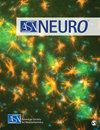HIV-1 Tat Inhibits Autotaxin Lysophospholipase D Activity and Modulates Oligodendrocyte Differentiation
IF 3.9
4区 医学
Q2 NEUROSCIENCES
引用次数: 5
Abstract
White matter injury has been frequently reported in HIV+ patients. Previous studies showed that HIV-1 Tat (transactivator of transcription), a viral protein that is produced and secreted by HIV-infected cells, is toxic to young, immature oligodendrocytes (OLGs). Adding Tat to the culture medium reduced the viability of immature OLGs, and the surviving OLGs exhibited reduced process networks. OLGs produce and secrete autotaxin (ATX), an ecto-enzyme containing a lysophospholipase D (lysoPLD) activity that converts lysophosphatidylcholine (LPC) to lysophosphatidic acid (LPA), a lipid signaling molecule that stimulates OLG differentiation. We hypothesized that Tat affects OLG development by interfering with the ATX-LPA signaling pathway. Our data show that Tat treatment leads to changes in the expression of OLG differentiation genes and the area of OLG process networks, both of which can be rescued by LPA. Tat-treated OLGs showed no change in LPA receptor expression but significantly decreased extracellular ATX levels and lysoPLD activity. In Tat transgenic mice, expression of Tat in vivo leads to decreased OLG ATX secretion. Furthermore, co-immunoprecipitation experiments revealed a potential physical interaction between Tat and ATX. Together, these data strongly suggest two functional implications of Tat blocking ATX’s lysoPLD activity. On one hand, it attenuates OLG differentiation, and on the other hand it interferes with the protective effects of LPA on OLG process morphology.抑制自身taxin溶血磷脂酶D活性和调节少突胶质细胞分化的HIV-1 Tat
白质损伤在HIV+患者中经常被报道。先前的研究表明,HIV-1 Tat(转录反激活因子)是一种由hiv感染细胞产生和分泌的病毒蛋白,对年轻的、未成熟的少突胶质细胞(OLGs)有毒性。在培养基中添加Tat降低了未成熟olg的生存能力,存活的olg表现出减少的过程网络。OLG产生并分泌autotaxin (ATX),一种含有溶血磷脂酶D (lysoPLD)活性的外酶,可将溶血磷脂酰胆碱(LPC)转化为溶血磷脂酸(LPA), LPA是一种刺激OLG分化的脂质信号分子。我们假设Tat通过干扰ATX-LPA信号通路影响OLG的发育。我们的数据表明,Tat处理导致OLG分化基因的表达和OLG过程网络的面积发生变化,这两者都可以通过LPA来挽救。经tat处理的OLGs没有改变LPA受体的表达,但显著降低了细胞外ATX水平和溶酶pld活性。在Tat转基因小鼠中,Tat在体内的表达导致OLG ATX分泌减少。此外,共免疫沉淀实验揭示了Tat和ATX之间潜在的物理相互作用。总之,这些数据强烈提示Tat阻断ATX的溶酶pld活性的两个功能含义。一方面减弱OLG分化,另一方面干扰LPA对OLG过程形态的保护作用。
本文章由计算机程序翻译,如有差异,请以英文原文为准。
求助全文
约1分钟内获得全文
求助全文
来源期刊

ASN NEURO
NEUROSCIENCES-
CiteScore
7.70
自引率
4.30%
发文量
35
审稿时长
>12 weeks
期刊介绍:
ASN NEURO is an open access, peer-reviewed journal uniquely positioned to provide investigators with the most recent advances across the breadth of the cellular and molecular neurosciences. The official journal of the American Society for Neurochemistry, ASN NEURO is dedicated to the promotion, support, and facilitation of communication among cellular and molecular neuroscientists of all specializations.
 求助内容:
求助内容: 应助结果提醒方式:
应助结果提醒方式:


